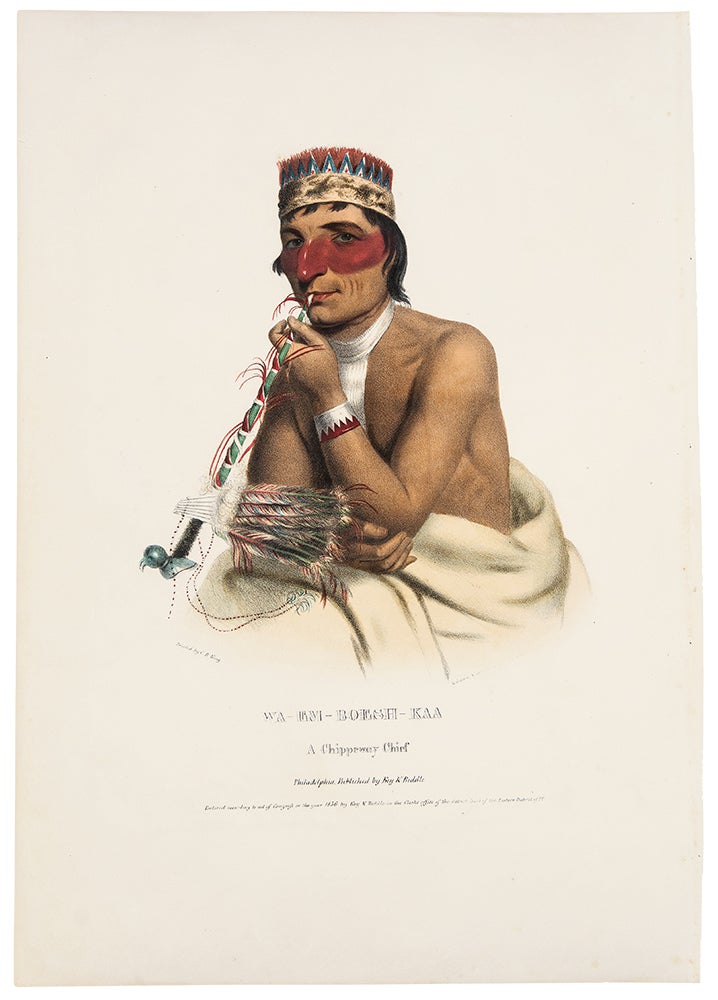MCKENNEY, Thomas L. (1785-1859) and James HALL (1793-1868)
Wa-Em-Boesh-Kaa, a Chippeway Chief
Philadelphia: Ke & Biddle, 1836. Hand-coloured lithograph. Sheet size: 20 x 14 1/2 inches.
A fine image from McKenney and Hall's "Indian Tribes of North America": "One of the most important [works] ever published on the American Indians" (Field), "a landmark in American culture" (Horan), and an invaluable contemporary record of a vanished way of life.
Waemboeshkaa (dates unknown) was an Ojibeway chief and a signer of the Fond du Lac treaty of 1826. McKenney was struck by the poverty of most of the tribespeople in attendance and so was deeply impressed by Waemboeshkaa, who had prepared rather regal adornments for the occasion. The crown-like cap was made of Mallard drake breast feathers and woodpecker beaks and feathers. His bracelet, necklace and pipe harmonized in color and design. His bearing too, according to McKenney, accorded with his exceptional costume. The peace or sacred pipe held a much higher place in Native life than was or is understood among whites. In part because of the health hazards discovered to derive from smoking tobacco, the beneficent narcotic effect has been defamed and so too the communal ritual of sharing the peace pipe. Or perhaps it is because the whites never felt bound by this particular communion to the kind of conscientious behavior a spiritual brother deserved. In any event, among the Indians themselves the pipe symbolized the serene state and the implied hope for peaceful relations, as well as contact with the invisible spirits above. The pipe was treated with great respect and appropriately adorned. Tobacco was burned among some tribes as a form of incense, without a pipe. McKenney and Hall's "Indian Tribes of North America" has long been renowned for its faithful portraits of Native Americans. The portraits are largely based on paintings by the artist Charles Bird King, who was employed by the War Department to paint the Indian delegates visiting Washington D.C., forming the basis of the War Department's Indian Gallery. Most of King's original paintings were subsequently destroyed in a fire at the Smithsonian, and their appearance in McKenney and Hall's magnificent work is thus our only record of the likenesses of many of the most prominent Indian leaders of the nineteenth century. Numbered among King's sitters were Sequoyah, Red Jacket, Major Ridge, Keokuk, and Black Hawk. After six years as Superintendent of Indian Trade, Thomas McKenney had become concerned for the survival of the Western tribes. He had observed unscrupulous individuals taking advantage of the Native Americans for profit, and his vocal warnings about their future prompted his appointment by President Monroe to the Office of Indian Affairs. As a director, McKenney was to improve the administration of Indian programs in various government offices. His first trip was during the summer of 1826 to the Lake Superior area for a treaty with the Chippewa, opening mineral rights on their land. In 1827, he journeyed west again for a treaty with the Chippewa, Menominee, and Winebago in the present state of Michigan. His journeys provided an unparalleled opportunity to become acquainted with Native American tribes. When President Jackson dismissed him from his government post in 1830, McKenney was able to turn more of his attention to his publishing project. Within a few years, he was joined by James Hall, a lawyer who had written extensively about the west. McKenney and Hall saw their work as a way of preserving an accurate visual record of a rapidly disappearing culture. .
Cf. BAL, 6934; cf. Bennett, p.79; cf. Field, 992; cf. Howes, M129; cf. Lipperhiede, Mc4; cf. Reese, Stamped With A National Character, 24; Sabin, 43410a.
Item #39650
Price: $950.00


